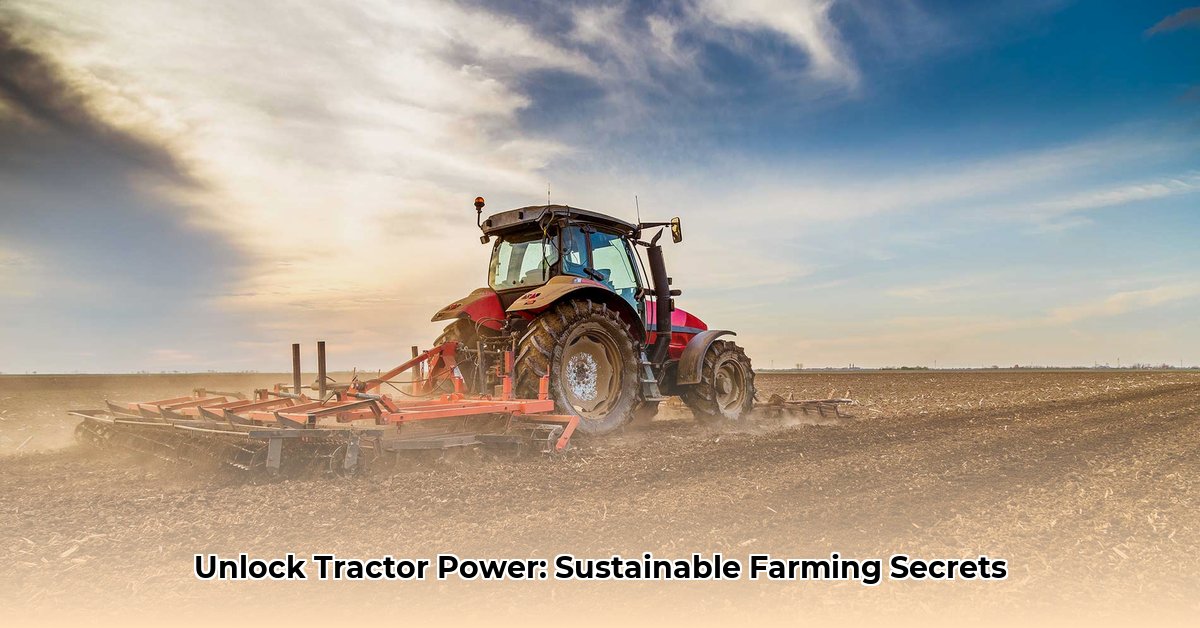
Understanding the Trade-offs: High-Horsepower Tractors in Sustainable Agriculture
High-horsepower tractors offer significant advantages in agricultural productivity, particularly on large-scale operations. However, their considerable cost and environmental impact necessitate a careful evaluation of their role within sustainable farming practices. For more on modern tractor technology, see this helpful resource: Modern Tractor Info. This article analyzes the economic and environmental implications of utilizing high-horsepower tractors, providing a framework for informed decision-making.
The Economic Landscape: Cost-Benefit Analysis of High-Power Tractors
The initial purchase price of a high-horsepower tractor represents a substantial investment. However, the total cost of ownership (TCO) extends far beyond this upfront expense. Factors such as fuel consumption, maintenance, repairs, insurance, taxes, and housing significantly impact the long-term financial implications. Smaller farms may find the TCO difficult to justify, while larger operations might see increased efficiency offsetting these costs. A thorough cost-benefit analysis, incorporating projected yield increases, is crucial for informed decision-making.
Calculating Total Cost of Ownership (TCO)
Two primary methods exist for calculating TCO: the detailed approach from Iowa State University and the streamlined UNL Agricultural Budget Calculator (ABC). Iowa State's method provides a more granular breakdown, encompassing depreciation, interest, taxes, insurance, and housing (TIH), integrating these into annual ownership costs. The UNL ABC offers a quicker calculation, but potentially lacks transparency, especially regarding TIH, which it treats as a separate overhead expense. This difference significantly impacts the final TCO estimate. A comprehensive approach considers not only these direct costs but also the indirect costs associated with repairs, fuel efficiency, and labor.
Incorporating Precision Agriculture
Implementing precision agriculture technologies such as GPS-guided systems can significantly reduce operational costs. These technologies optimize resource usage (fertilizer, pesticides, fuel), leading to higher yields and reduced waste. While the upfront investment in these technologies can be significant, long-term cost savings and increased efficiency make them a worthwhile consideration in the TCO calculation.
Lifecycle Cost Analysis (LCA)
For a holistic perspective, a lifecycle cost analysis (LCA) provides a comprehensive assessment of the tractor's cost across its entire lifespan. This includes the initial purchase price, fuel consumption over time, maintenance and repair expenses, eventual resale value, and even the environmental costs associated with manufacturing and disposal. This broader perspective is essential for long-term financial planning.
Environmental Considerations: Minimizing the Ecological Footprint
While high-horsepower tractors boost efficiency, their environmental impact cannot be ignored. High fuel consumption contributes significantly to greenhouse gas emissions, directly contradicting the principles of sustainable agriculture. The scale of operations often supported by these powerful machines also raises concerns about habitat loss and biodiversity reduction.
Mitigation Strategies
Several strategies can mitigate the environmental impact of high-horsepower tractors:
- Precision Agriculture: Optimizes resource use, minimizing waste and reducing fuel consumption.
- Alternative Fuels: Exploring biofuels and other alternative fuels can reduce greenhouse gas emissions.
- Regular Maintenance: Extends tractor lifespan, reduces the need for frequent replacements, and minimizes repair costs.
- Sustainable Farming Practices: Coupling high-horsepower tractors with environmentally conscious farming techniques is essential for minimizing overall ecological impact.
Actionable Steps for Sustainable Tractor Use
- Assess Farm Needs: Evaluate farm size and workload before committing to a high-horsepower tractor. Smaller, more fuel-efficient models might suffice.
- Explore Financing Options: Research leasing or other financing options to manage the significant upfront costs.
- Implement Precision Agriculture: Utilize GPS-guided systems and other precision technologies to maximize efficiency and minimize waste. This can lead to a 10-15% reduction in input costs, depending on the specific application.
- Monitor Fuel Consumption: Regularly track fuel usage and adjust operating practices to improve fuel efficiency. Implementing fuel-saving techniques can improve efficiency by 5-10%.
- Prioritize Preventative Maintenance: Regular maintenance significantly extends tractor lifespan and minimizes costly repairs. A well-maintained tractor can operate at peak efficiency for extended periods.
- Embrace Technological Advancements: Stay informed about advancements in fuel-efficient engines and autonomous operation. These innovations can significantly reduce both operational costs and environmental impact.
Key Takeaways: Balancing Productivity and Sustainability
- TCO is Crucial: Accurately calculating TCO, including both fixed and variable costs, is essential for sustainable farming. This includes a lifecycle approach, considering the entire lifespan of the machinery.
- Precision Agriculture Reduces Costs: Implementing precision agriculture technology offers significant long-term cost savings by optimizing resource use and minimizing waste.
- Environmental Impact Matters: The environmental footprint of high-horsepower tractors must be considered. Mitigation strategies are crucial for aligning tractor use with sustainable farming practices. This includes careful consideration of fuel usage and emission reductions.
This guide provides a framework for evaluating high-horsepower tractors within the context of sustainable agriculture, emphasizing the importance of a comprehensive cost-benefit analysis and the adoption of environmentally responsible practices. The ultimate decision will depend upon a careful balancing of economic considerations and environmental responsibility.